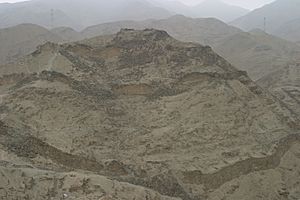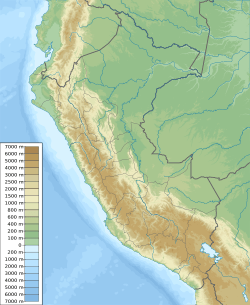Acaray facts for kids

Fortified hilltop at Acaray
|
|
| Location | Lima Region, Peru |
|---|---|
| Region | Norte Chico |
| Coordinates | 11°03′31″S 77°31′59″W / 11.05861°S 77.53306°W |
| Type | Fortification |
| Area | 23 ha (57 acres) |
| History | |
| Founded | 900–200 BC |
| Abandoned | 1000–1470 AD |
| Periods | Early Horizon to Late Intermediate Period |
For the hydroelectric power plant and HVDC-back-to-back facility in Paraguay, see Acaray Power Plant
Acaray, also known as the Fortress of Acaray, is an ancient archaeological site in Peru. It is located on the coast, in the Huaura River Valley. This area is part of the Norte Chico region.
Acaray is an impressive fortress built on three hilltops. Each hilltop has several strong defensive walls. These walls include special features like parapets (low protective walls) and bastions (parts of the wall that stick out). These features show that Acaray was a military site. Scientists used radiocarbon dating to figure out its age. They believe it was built between 900 and 200 BC. People stopped living there between 1000 and 1470 AD. Around the fortress, there were areas where people lived and large cemeteries. Sadly, many of these areas have been looted over time.
Contents
Discovering Acaray's Secrets
People started paying attention to Acaray a long time ago. The German archaeologist Hans Horkheimer wrote about it in 1962. His article appeared in a Peruvian magazine called Caretas.
Early Explorations
Horkheimer called the site the Fortaleza de Huaura. He believed Acaray was a true fortress. He thought it was different from the nearby site of Paramonga, which some people questioned as a real fort. Horkheimer also noticed many round river cobbles on the ground. These stones were probably used as projectiles or slingstones in battles.
First Archaeological Digs
In the 1970s, more people became interested in Acaray. This is when archaeologists began their first studies at the fortress. A Peruvian archaeologist named Mercédes Cárdenas led a team. She worked for the Riva Agüero Institute. Her project aimed to understand how ancient people used resources from the sea on the Peruvian coast. She also wanted to get radiocarbon dates for the sites.
Cárdenas and her team explored the Huaura Valley. They dug at several sites, including the hilltop fort at Acaray. Her work helped confirm the dates for Acaray. She estimated it was built around 900–200 BC and abandoned between 1000–1470 AD.
Around the same time, two other Peruvians visited the fortress. They were archaeologist Arturo Ruiz Estrada and engineer Domingo Torero. They wrote a detailed report describing the buildings and walls of the site.
Modern Research
In 2004, a North American archaeologist named Margaret Brown Vega started new research at Acaray. She was from the University of Illinois at Urbana-Champaign. For two years, she carefully mapped the site. She also studied the surface and carried out new excavations.
Brown Vega believes that Acaray's early large stone walls might be similar to those found at Chankillo. Chankillo is another ancient site from the same time period.
See also
 In Spanish: Fortaleza de Acaray para niños
In Spanish: Fortaleza de Acaray para niños


